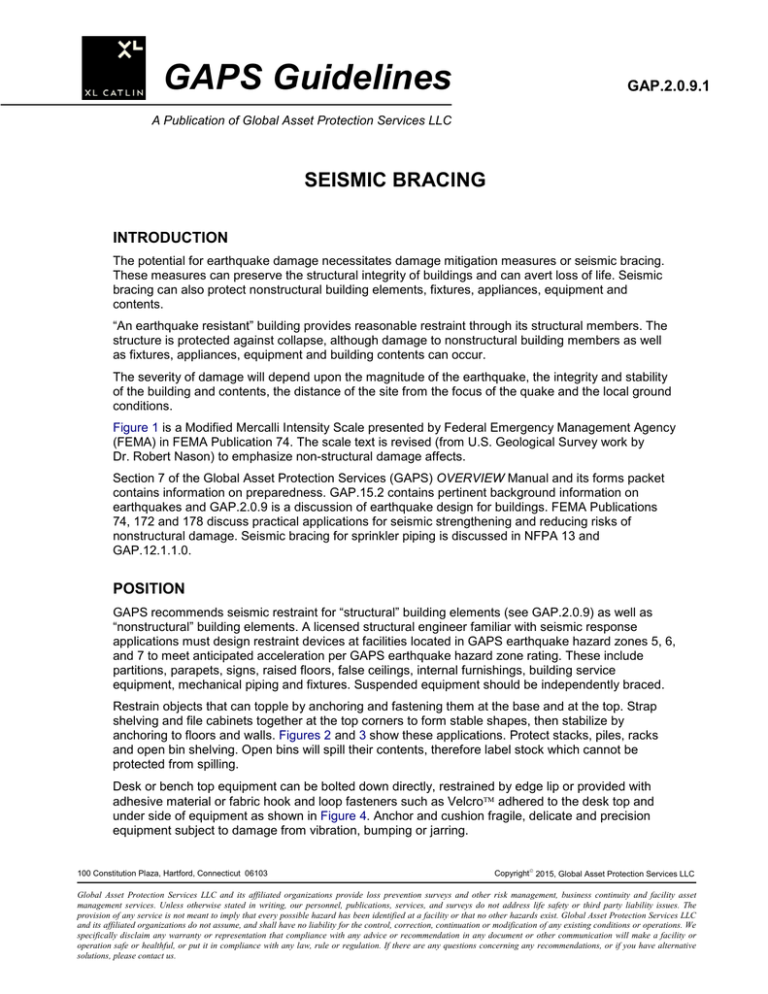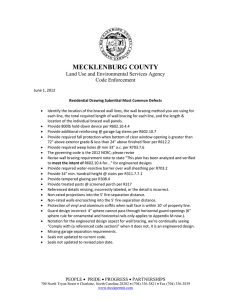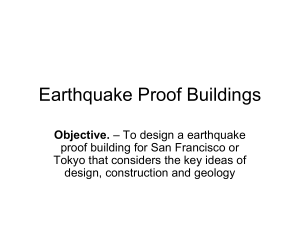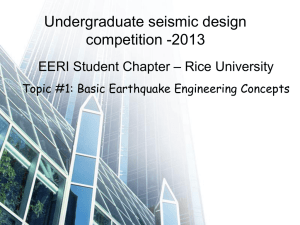Seismic Bracing
advertisement

GAPS Guidelines GAP.2.0.9.1 A Publication of Global Asset Protection Services LLC SEISMIC BRACING INTRODUCTION The potential for earthquake damage necessitates damage mitigation measures or seismic bracing. These measures can preserve the structural integrity of buildings and can avert loss of life. Seismic bracing can also protect nonstructural building elements, fixtures, appliances, equipment and contents. “An earthquake resistant” building provides reasonable restraint through its structural members. The structure is protected against collapse, although damage to nonstructural building members as well as fixtures, appliances, equipment and building contents can occur. The severity of damage will depend upon the magnitude of the earthquake, the integrity and stability of the building and contents, the distance of the site from the focus of the quake and the local ground conditions. Figure 1 is a Modified Mercalli Intensity Scale presented by Federal Emergency Management Agency (FEMA) in FEMA Publication 74. The scale text is revised (from U.S. Geological Survey work by Dr. Robert Nason) to emphasize non-structural damage affects. Section 7 of the Global Asset Protection Services (GAPS) OVERVIEW Manual and its forms packet contains information on preparedness. GAP.15.2 contains pertinent background information on earthquakes and GAP.2.0.9 is a discussion of earthquake design for buildings. FEMA Publications 74, 172 and 178 discuss practical applications for seismic strengthening and reducing risks of nonstructural damage. Seismic bracing for sprinkler piping is discussed in NFPA 13 and GAP.12.1.1.0. POSITION GAPS recommends seismic restraint for “structural” building elements (see GAP.2.0.9) as well as “nonstructural” building elements. A licensed structural engineer familiar with seismic response applications must design restraint devices at facilities located in GAPS earthquake hazard zones 5, 6, and 7 to meet anticipated acceleration per GAPS earthquake hazard zone rating. These include partitions, parapets, signs, raised floors, false ceilings, internal furnishings, building service equipment, mechanical piping and fixtures. Suspended equipment should be independently braced. Restrain objects that can topple by anchoring and fastening them at the base and at the top. Strap shelving and file cabinets together at the top corners to form stable shapes, then stabilize by anchoring to floors and walls. Figures 2 and 3 show these applications. Protect stacks, piles, racks and open bin shelving. Open bins will spill their contents, therefore label stock which cannot be protected from spilling. Desk or bench top equipment can be bolted down directly, restrained by edge lip or provided with adhesive material or fabric hook and loop fasteners such as Velcro adhered to the desk top and under side of equipment as shown in Figure 4. Anchor and cushion fragile, delicate and precision equipment subject to damage from vibration, bumping or jarring. 100 Constitution Plaza, Hartford, Connecticut 06103 Copyright 2015, Global Asset Protection Services LLC Global Asset Protection Services LLC and its affiliated organizations provide loss prevention surveys and other risk management, business continuity and facility asset management services. Unless otherwise stated in writing, our personnel, publications, services, and surveys do not address life safety or third party liability issues. The provision of any service is not meant to imply that every possible hazard has been identified at a facility or that no other hazards exist. Global Asset Protection Services LLC and its affiliated organizations do not assume, and shall have no liability for the control, correction, continuation or modification of any existing conditions or operations. We specifically disclaim any warranty or representation that compliance with any advice or recommendation in any document or other communication will make a facility or operation safe or healthful, or put it in compliance with any law, rule or regulation. If there are any questions concerning any recommendations, or if you have alternative solutions, please contact us. GAP.2.0.9.1 Anchor floor mounted equipment such as indoor transformers and switchgear and brace at the top to structural elements: Brace floor stands for items such as horizontal tanks, and battery racks in two opposing directions as shown in Figures 5 and 6. Fit operating equipment requiring highly flexible shock absorbing mounts with restraints and motion stops such as shown in Figure 7. LIGHT I-IV: from barely perceptible to mild shaking without damage V: Felt by nearly everyone, and many are awakened if the earthquake occurs at night. Some dishes or other fragile shelf items fall and break. Cracked plaster or drywall in a few places. Movement of trees, power lines, and other tall flexible objects noticed. Pendulum clocks may stop. Water may slosh in swimming pools. Only a few shelf items in grocery stores shifted or fallen. Flexible items such as liquids in containers, tall floor lamps or chandeliers, etc., may move more than other more rigid objects such as furniture. Windows or contents of cabinets may rattle. SEVERE MODERATE VI: Felt by all, many frightened. The top portion of some unreinforced brick chimney on houses are damaged. Some furniture shifted slightly. Shelf items throughout a grocery store may fall, but not to the extent that it is difficult to walk through all of the aisles. Cracks or occasional falling of pieces of plaster. Occasional large storefront windows cracked. VII: Everyone notices and is alarmed by the earthquake. Persons driving automobiles notice the shaking. Unreinforced chimney damage common to older houses affects less than half of buildings. Many or most aisles of grocery stores blocked by fallen shelf items. Some spring mounted but not seismically restrained heating-ventilatingair conditioning equipment begins to shift but generally does not fall off its spring supports. VIII: Many find it difficult to keep balance while standing. Shaking interferes with driving of automobiles. Widespread unreinforced chimney damage. Pipes may leak in buildings. Suspended ceilings without diagonal bracing partially fall. Spring mounted mechanical equipment without seismic restrainers breaks supports and falls. Tall unanchored shelving and storage racks lose contents or tip over. IX: The shaking is very alarming to everyone and it is very difficult to stand. Widespread overturning of unanchored equipment if about twice as tall as wide, including some television set-sized items on tables or desks. Most unanchored shelving overturns. Sliding of other unanchored items. X: Unusually severe ground motion, such as has been observed in only a very few earthquakes. People thrown to ground and cannot stand up. Most unanchored nonstructural objects except tables and desks fall. Objects do not fly through air but may bounce and overturn due to vertical shaking. Figure 1. Modified Mercalli Intensity Scale Revised To Emphasize Nonstructural Damage Affects. (From FEMA Publication 74). GAPS Guidelines 2 A Publication of Global Asset Protection Services LLC GAP.2.0.9.1 Figure 2. Restrain From Toppling. Figure 3. Stabilize Shape. Figure 4. Anchor To Desktop. Figure 5. Braced Floor Stand. GAPS Guidelines 3 A Publication of Global Asset Protection Services LLC GAP.2.0.9.1 Figure 6. Braced Rack. Figure 7. Motion Stops. Provide flexible connections for piping and wiring conduits at isolation, shock absorption and energy dissipating installations or where vibrations will differ significantly. For example, anchor a suction tank to its foundation and anchor the pump and driver separately as a unit assembly to a base on the floor of the adjoining pump hose. The tank will oscillate at a different fundamental frequency in an earthquake than the pump house and pump assembly. Use flexible connectors in the piping between the pump and tank. Use of flexible connectors for piping at building entrances, across faults and ground/soil type changes (soil vs rock). Also provide emergency equipment, such as power generators, with this protection. The potential for rupture of water, gas and fuel, electrical supply and communication conduits (piping or wiring) is high, particularly where materials are brittle types. Provide isolation valves and switches, excess flow safety devices and disconnects to minimize damage and retain as much service as possible. Sway brace and securely support ceiling tiles, light fixtures, diffusers and other hanging objects. Figure 8 shows bracing for ceiling mounted and suspended components in opposing directions. Lateral bracing for suspended ceilings and lighting fixtures is shown in Figures 9 and 10. The concept is also used for ducts, piping, cable trays and other equipment as shown in Figures 11 through 14. Nonstructural elements of buildings can be strengthened by bracing or improving fastenings also. Parapets, building appendages, interior partitions, signs and stacks are usually exposed and lend themselves to bracing attachment. Mechanical and electrical equipment whether floor, wall or ceiling mounted should be securely anchored, (bolted or welded) to minimize movement. Piping, cable trays, ductwork and wiring conduits can be braced and strapped. Raised floors, such as computer room floors and dropped ceilings can also be braced and equally important, equipment should be braced with and through the supplemental floor or ceiling to structural members. Production and process equipment responds to earthquake forces in like manner and should also be anchored, braced and restrained. Any non-structural component or building element which can break away, tip, topple, slide or fall needs to be secured at top and base, braced and restrained or isolated and restrained. GAPS Guidelines 4 A Publication of Global Asset Protection Services LLC GAP.2.0.9.1 Figure 8. Duct Bracing. Figure 9. Drop Ceiling Bracing. Figure 10. Ceiling Fixture Brace. Figure 11. Duct Bracing. GAPS Guidelines 5 A Publication of Global Asset Protection Services LLC GAP.2.0.9.1 Figure 12. Sidewall Pipe Bracing. Figure 13. Ceiling Pipe Bracing. Figure 14. Ceiling Pipe Bracing. DISCUSSION As noted in GAP.2.0.9 the principal cause of damage in an earthquake is shaking which results from the effects of vibration originating at the source of the earthquake. The same principles of seismic design apply to existing structures as well as new building design. The technique for strengthening of existing buildings differs in connecting to, infilling between and reinforcing elements of construction already in place. An existing building structural system can be improved (strengthened) by addition of reinforcement, addition of redundant elements or provision of a supplemental system. GAPS Guidelines 6 A Publication of Global Asset Protection Services LLC GAP.2.0.9.1 Cover plates can be used to modify steel beams and columns (see Figures 15 and 16). Concrete elements can be encased in reinforced concrete for added stiffness. A reinforced concrete shear wall can be infilled within an existing frame opening to strengthen the structure. Bracing by diagonal strapping (Figure 17) or, in steel construction, braced frame designs ranging from X-brace and K-brace to tension rod bracing is used to strengthen structural frames. Supplemental strengthening in the vertical plane can take the form of additional bay bracing or buttress bracing. Floors and roof which typically transmit forces in the horizontal plane can be strengthened by tightening fastenings, nailing attachments and connections. Add supplemental capacity, such as an overlay wood or steel beam, plywood sheeting or reinforced concrete casting. The intent is to improve stiffness of the structure and minimize or eliminate free gap space between elements. On occasion to improve the seismic response of a building it may be more practical to provide a complete redundant braced frame, remove an upper story, provide an energy absorption system employ a base isolation system, or become involved in major reconstruction. Floor to wall and wall to roof connections are critical points of fastening. Footings and foundations also may need to be improved, particularly if the structure is sited on poor ground or soft soils. Underpinning of footings and supplemental piles are viable methods of strengthening the building base. Attachment of wall to foundations connectors may also need to be toughened to resist uplift (improve hold down) as well as to resist shear. Contents of buildings, if not adequately anchored, supported or braced, can be damaged. Building utilities such as boilers, pumps and piping, transformers, substations, domestic water, air and gas piping and emergency equipment will be exposed to earthquake motions. Underground piping is subject to rupture by shear and tension, offset, compression buckling and joint rupture. Fixtures, furniture and standing equipment can topple, fall, slide or tip, spill stock and collapse. Equipment on desks or benches may slide off, ceiling tiles fall, partitions crack and break and glass windows break. Piled stock may topple. Equipment not properly anchored to the floor may slide or tip and pull wires and pipe connections. Container leakage can also be serious. Inline units may misalign. Control equipment in particular may be susceptible to shaking and shake damage. Figure 15. Beam Stiffener. GAPS Guidelines 7 A Publication of Global Asset Protection Services LLC GAP.2.0.9.1 Figure 16. Column Stiffener. Figure 17. Wall X Brace. GAPS Guidelines 8 A Publication of Global Asset Protection Services LLC





